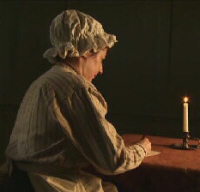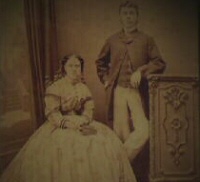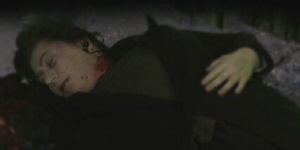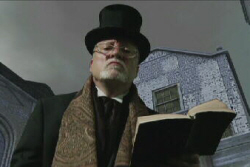Annie Chapman
Hanbury Street
As our reconstruction shows, Jack the Ripper was acting spontaneously and very quickly, perhaps drawing on local knowledge. Jack strangled his
victims from the front causing blood pressure to fall ensuring that there were limited blood-spurt when, having lowered them to the ground, he
quickly cut the throats, twice, to ensure their silence.
The mutilation of the victims was performed post-mortem. That combination of extreme violence and opportunism would almost certainly mean, that
today, the killer known as Jack the Ripper would be labelled a psychotic serial killer.

Polly Nichols
Mary Ann Nichols was buried on 6 September in a polished elm coffin by a Hanbury Street undertaker. Ironically, in a little over one week it will
be the residents of Hanbury Street who would wake up to an even worse outrage, literally, on their very doorstep.
Today 29 Hanbury Street no longer exists but, carefully reconstructing the street as it was then reveals number 29 as a three storey building with a
garret for a fourth floor. In 1888, the eight rooms in this one-time family-home were occupied by 17 people. The front door opened into a hallway
leading the length of the house to a rear door and beyond that a yard.
Annie Chapman was probably born in Paddington in 1840 and was married in 1869. A photograph that has been passed down to a descendant shows the
marriage. This is the only remaining photograph of any of the victims while they were alive it suggests that a respectable and happy future was
assured for the young couple.

Annie Chapman Wedding
But, Annie was an alcoholic and would be seen wandering through the countryside drunk. She was an embarrassment to her employer. John, her
husband, was working as a coachman for a rich baronet in Windsor. John was forced to abandon her to save his job.
Annie Chapman ended up in the East End, in 1888, living at Crossingham's lodging house in Dorset Street. Dorset Street was lined with decaying
buildings most converted into common lodging or doss houses. Some catering for as many as 400 people every night.
A notorious thoroughfare known for it's disreputable characters and lawlessness, Annie remained here until her death taking up hawking and
prostitution. According to the subsequent investigation on the late afternoon of September 7 Annie was seen by a friend in Dorset Street. In the
early hours of the next morning she was found eating a baked potato in the doss house kitchen by the night watchman John Evans who'd been sent to
collect the doss money. She didn't have it. He watched her leave and make her way down Little Paternoster Row towards Spitalfields.

Annie Chapman
By carefully piecing together the testimony of people in Hanbury Street in the early hours of that morning it is possible to come to a
likely scenario. At 5.30 Elizabeth Long was walking past number 29 Hanbury Street on her way to Spitalfields market when she saw a woman,
who she believed was Annie Chapman, standing with a man by the shutters of the house. She was certain of the time as she had just heard
the brewery clock strike the half-hour.
At about the same time, Albert Cadoch who was suffering from a urinary infection made one of several visits into next door's backyard to
visit the outside toilet. Then Cadoch heard what he thought was something fall against the fence in the yard next door but thought nothing
of it. He left for work but didn't see Mrs Long or anyone standing outside number 29. It was in the yard at number 29 less than 13 minutes
later that Annie Chapman's mutilated body was found by resident John Davies.
It became immediately clear that Annie Chapman had been the subject of an attack of unprecedented ferocity. Dr Baxter-Phillips carried
out the post-mortem. Her intestines had been removed and draped around the shoulders of the corpse and the vagina and uterus were completely removed.
Dr Phillips cataloguing of the injuries suggested, to him, that the killer had to be a medical man or, at the very least, someone who had a
working knowledge of anatomy. And his conclusions about the time of death and how much time was needed to perform the mutilations would help
build the myth that Jack the Ripper was a doctor. Dr Baxter-Phillips conclusion that the murderer possessed anatomical or pathological knowledge
and had sufficient skill to quickly cut out the organs encouraged the police to begin investigating doctors and medical students.

Dr. Baxter-Phillips
But, our reconstruction shows some of Dr Phillips conclusions may have misdirected the police investigations. From his examination of the
corpse Dr Phillips put the time of death at 4:30 or possibly earlier but, John Richardson had been sitting on the top step at 4:45 15 minutes
after the time of death estimated by the doctor. But, did not see a body or smell a disembowelled corpse. Then the evidence of Albert Cadoch
who left his home at 5:30, the same time as Annie Chapman had been seen in the street by Elizabeth Long, but he saw nobody.
As the morning wore on and news of the murder spread, public anxiety turned into panic. Residents of the neighbouring houses did brisk
business renting out rooms that overlooked the yard.

John Pizer
It was newspaper pressure that led to the first significant arrest in the case as The Star newspaper pushed its pet theory that the mystery
Jewish man known as leather-apron was behind the deaths. In one particularly lurid account, The Star described him as an noiseless midnight
terror who preyed on the local prostitutes. Suspicion quickly fell on a man named John Pizer, a Jewish slipper maker who went by the same
nickname of leather-apron.
On 10 September the police went to Pizer's home in Whitechapel. Various newspapers heaped abuse on Peiser but, unfortunately for the police,
he was able to prove that he was nowhere near Whitechapel on the night of the murders. But the leather-apron scare did much to fuel anti-Semitism
in Whitechapel. This London had become a home to Russian Jewish refugees. The change in the area's fragile ethnic balance had resulted in the rise
of violent anti-Semitism.
Annie Chapman was buried in an unmarked grave on 14 September 1888. The inquest jury returned yet another verdict of wilful murder
against person or persons unknown.




